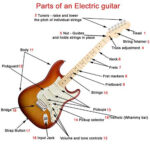For anyone starting their musical journey, the acoustic guitar is often the instrument of choice. Its portability, versatility, and warm sound make it incredibly appealing. But have you ever wondered how an acoustic guitar actually produces its sound? Understanding the mechanics behind this beloved instrument can deepen your appreciation and guide you in your learning process.
The Science of Sound: How Acoustic Guitars Create Music
Unlike electric guitars that rely on pickups and amplifiers, acoustic guitars are purely mechanical marvels. Their sound originates from the vibration of the strings, but it’s the guitar’s body that amplifies and shapes this vibration into the rich tones we recognize.
The key component is the soundboard, typically the top piece of wood on the guitar. When you pluck or strum a string, its vibrations are transferred through the bridge and saddle to the soundboard. Think of the soundboard as a speaker cone; it’s a large surface designed to move air. As the soundboard vibrates, it pushes and pulls the surrounding air, creating sound waves that travel to our ears. The larger the soundboard and the more efficiently it vibrates, the louder the guitar.
Adding to this is the hollow body of the acoustic guitar. This cavity acts as a resonating chamber. The sound waves produced by the soundboard bounce around inside the body, further amplifying and enriching the sound, especially in the lower frequencies, giving the guitar its fullness and warmth.
The tonewoods used to construct the guitar body, particularly the soundboard, back, and sides, play a crucial role in the guitar’s tonal characteristics. Different types of wood possess unique densities and resonant properties, influencing the sustain, clarity, and overall timbre of the instrument. Construction techniques, like bracing patterns beneath the soundboard and bridge design, also contribute significantly to the unique sonic signature of each acoustic guitar. This complex interplay of factors is why each acoustic guitar possesses its own distinctive voice.
Exploring Different Types of Acoustic Guitars for Beginners
When starting your acoustic guitar journey, it’s helpful to know that there are two primary types you’ll encounter: steel-string acoustic guitars and classical guitars.
Steel-String Acoustic Guitars: The Popular Choice for Many Genres
Steel-string acoustic guitars are the more modern variation and are incredibly versatile, popular across genres like folk, rock, country, and pop. As the name suggests, they utilize steel strings, which produce a brighter, louder, and more resonant sound compared to nylon strings.
The most iconic body shape for steel-string acoustics is the dreadnought. Pioneered by C.F. Martin & Company, the dreadnought is characterized by its large, deep body and broad shoulders. This design contributes to a powerful and balanced tone, making it a favorite for strumming and vocal accompaniment. The Martin D-28, introduced in 1931, remains a legendary example of the dreadnought design. Beyond dreadnoughts, you’ll find other body styles like the larger jumbo for even bigger sound, and smaller bodies like auditorium (000) and grand concert (00) which offer more focused tones and greater playing comfort, especially for beginners or players with smaller frames.
Classical Guitars: Nylon Strings and Fingerstyle Focus
Classical guitars represent a direct lineage to the Spanish guitar and are characterized by their nylon strings. These strings are softer on the fingertips, making them a comfortable option for beginners, especially children or those sensitive to the pressure of steel strings. Classical guitars are traditionally designed for classical, flamenco, and fingerstyle guitar playing.
The construction, size, and materials of classical guitars are distinct from steel-string models, contributing to their warmer, mellower, and more delicate sound. They are typically played with fingers rather than a pick, emphasizing nuanced fingerstyle techniques. While shapes can vary, they generally adhere to either the modern classical guitar shape or historical designs, like those from the Romantic era.
Choosing between a steel-string and classical guitar as a beginner often depends on your musical preferences and desired playing style. Both offer unique sonic palettes and playing experiences, but understanding how they work at a fundamental level provides a solid foundation for your musical exploration.


